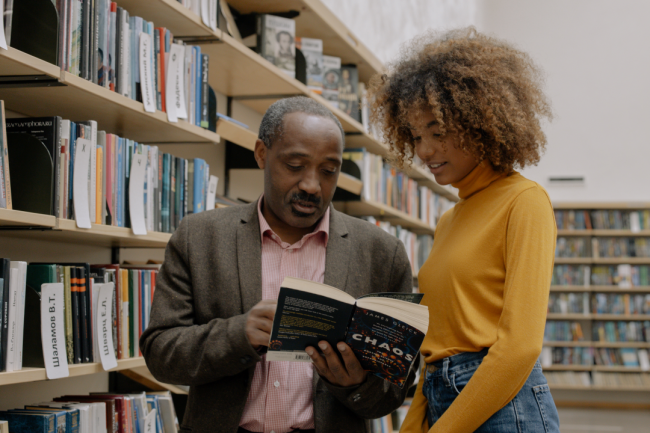You have /5 articles left.
Sign up for a free account or log in.

AIM gives faculty and staff members best practices in mentoring undergraduate students.
Cottonbro Studio/Pexels
Mentors teach college students invaluable lessons for their time in school, in their careers and for life in general, but who’s teaching mentors?
A professor from California State University, Long Beach, created the Advanced Inclusive Mentoring program to share best practices for inclusive mentoring of undergraduate learners to set them up for success in college and beyond.
AIM, part of the National Institutes of Health Building Infrastructure Leading to Diversity (BUILD) Initiative, shares stories from mentors, gives case studies and provides tools for a successful mentoring relationship, touching on issues like social justice, equity, combating discrimination and cultural awareness in mentoring.
Since the program’s conception, Cal State Long Beach has trained 480 mentors and shared its curriculum with other colleges within and outside the CSU system.
The what: CSULB biology professor Kelly Young, who started AIM, previously taught a mentorship training using the Entering Mentoring curriculum, focused on mentors of research trainees across undergraduate and graduate populations, as well as postdoctoral researchers.
Institutions in the Cal State system, however, are primarily undergraduate serving, so the curriculum wasn’t relevant to the issues faced at CSULB or other CSU campuses.
California Polytechnic State University, San Luis Obispo, piloted AIM this summer in part because many Cal Poly students participate in faculty-led research. This summer, 400 students are involved in student research and creative activity fellowships supported by the campus, says Jane Lehr, director of the office of student research and interim director of research engagement in the college of liberal arts.
Many mentors in the CSU also come with prior experience working with students, so they don’t need a 101 course but instruction on best practices and how to be inclusive across experiences.
“It’s similar to, you know, many people who get Ph.D.s aren’t actually trained to teach,” Lehr says. “And then we’re learning to teach, and become great educators in many cases, but we don’t have necessarily the resources that could have supported our development and made things easier.”
As a result, Young developed AIM to address the unique demographic needs of the students they serve and the lived experiences of the mentors in the community.
The who: AIM seeks to bridge the gap and spark thoughtfulness behind mentorship practices, particularly in working with students from diverse racial and ethnic groups and promoting inclusion. The program model allows for flexibility in delivery and application, but all participating institutions complete the same curriculum, Young says.
At Cal Poly, the program is open to faculty and staff members, as well as postdoctoral and graduate students. CSULB recommends groups of eight to 10 participants each training, although Cal Poly San Luis Obispo piloted the program with 35 participants this summer.
The how: AIM participants move through six learning modules:
- connecting with mentees
- inclusive mentoring
- cultivating mentee growth and development
- facilitating mentee health and well-being
- mentee-centered mentoring
- mentoring toolbox
As part of those modules, participants watch 35 short videos (one for each submodule) and six quizzes (which they can retake). The modules take just under one hour each to complete.
Each video features a faculty host from CSULB in a specific discipline, who offers best practices. Topics include social justice mentoring, combating discrimination, virtual communication tips, culturally aware mentoring, defining the role of a mentor and holistic development of students personally and professionally.
Some videos are case scenarios acted out by film students or animated demonstrations. All case studies in the videos are based on real student stories collected by Young in surveys and one-on-one interviews.
Content is housed on CSU’s systemwide Canvas, and all participants receive a unique login to track data, Young says.
After each learning module, participants meet to reflect and share ideas from the lessons during a one-hour facilitated discussion, kind of like a book club, Young says.
At Cal Poly, everyone meets in one Zoom meeting, but then participants break off into three randomized small groups to discuss content over a 50-minute session. Lehr facilitates one of the groups, and her colleagues Bridget Benson, associate dean of the college of engineering, and Luna Larson, program director of Empowering Autistic Scholars, facilitate the others.
July 13 was Cal Poly’s final meeting, and program participants discussed topics like inclusive evaluations, mentorship legacy and changes to their mentoring practices participants hope to make, such as creating a mentoring philosophy, establishing a compact or adding values to research group books.
Upon completion at any institution, AIM students receive a certificate for completing the asynchronous lessons and participating in facilitated discussion and sometimes additional recognition from their institution.
CSU Long Beach faculty can also earn a “Beach Mentor Community Member” designation, which meets review criteria for selected funding awards around students in research. Cal Poly faculty, staff and administrators who participate may be eligible for a $300 stipend from the Center for Teaching, Learning and Technology, as well.
The impact: Young published an initial research paper after piloting the program at CSULB and has since expanded data collection across campuses. Overwhelmingly, participants most enjoyed the facilitated, live discussions about mentorship and have appreciated gleaning insight from others at their institutions.
In the future, Young and her colleagues are partnering with the National Research Mentoring Network to incorporate the AIM program and make it more widely available through their MyNRMN course catalog, as well.
After concluding their pilot program, Cal Poly San Luis Obispo facilitators will analyze survey responses from program participants for an evaluation. Lehr envisions AIM becoming a regular training at the university, but with changes to the program to make it more specific to Cal Poly’s climate and students.
If your student success program has a unique feature or twist, we’d like to know about it. Click here to submit.




